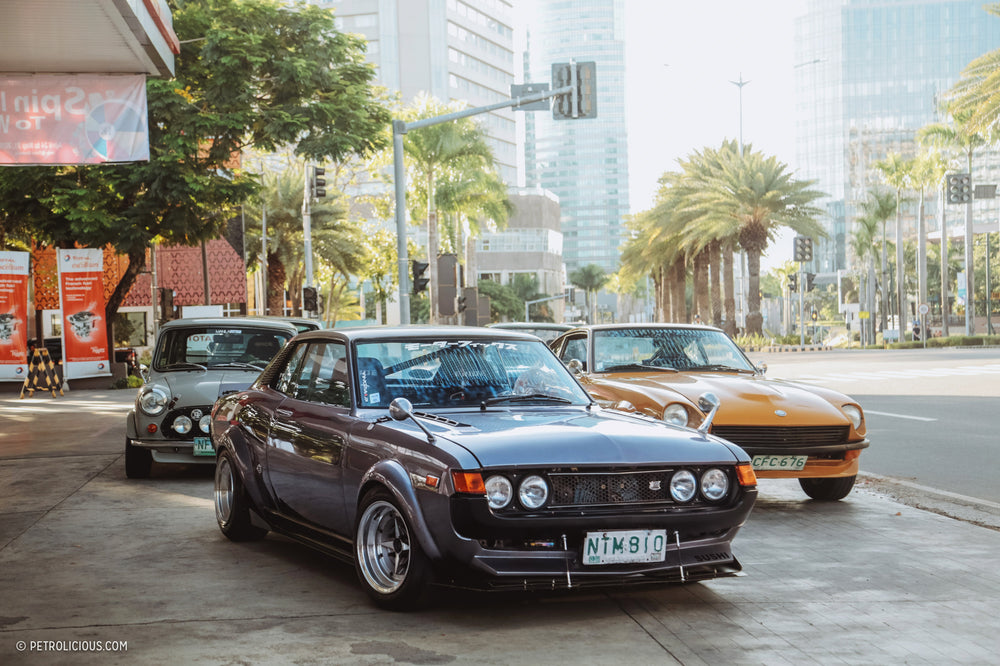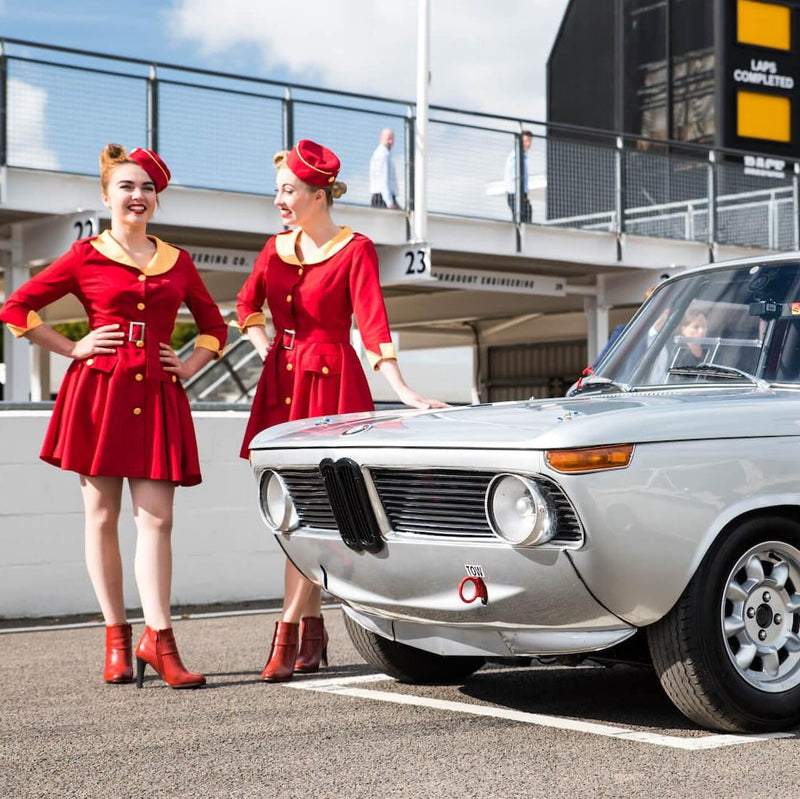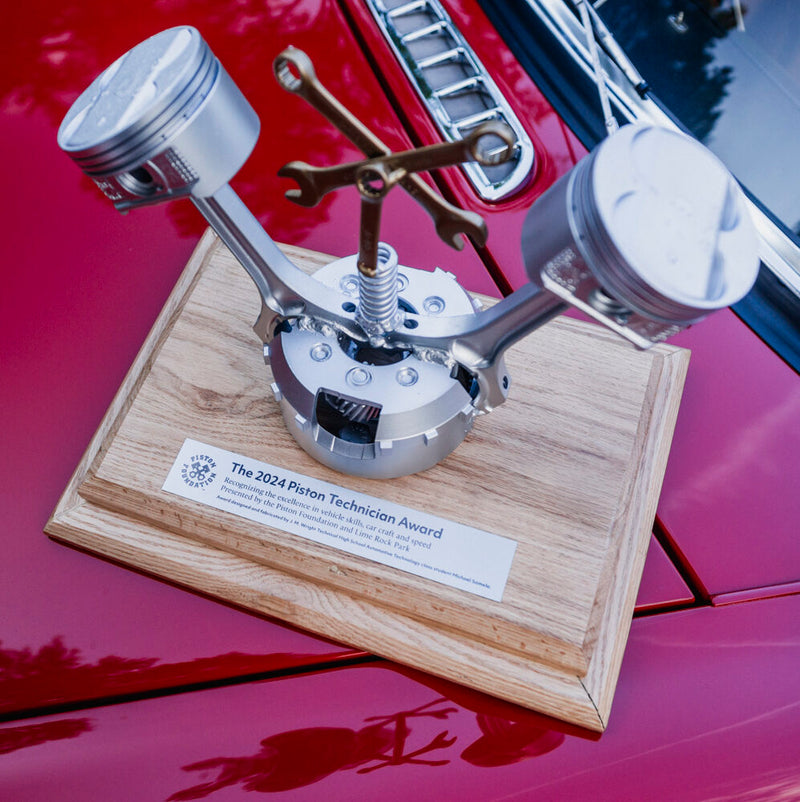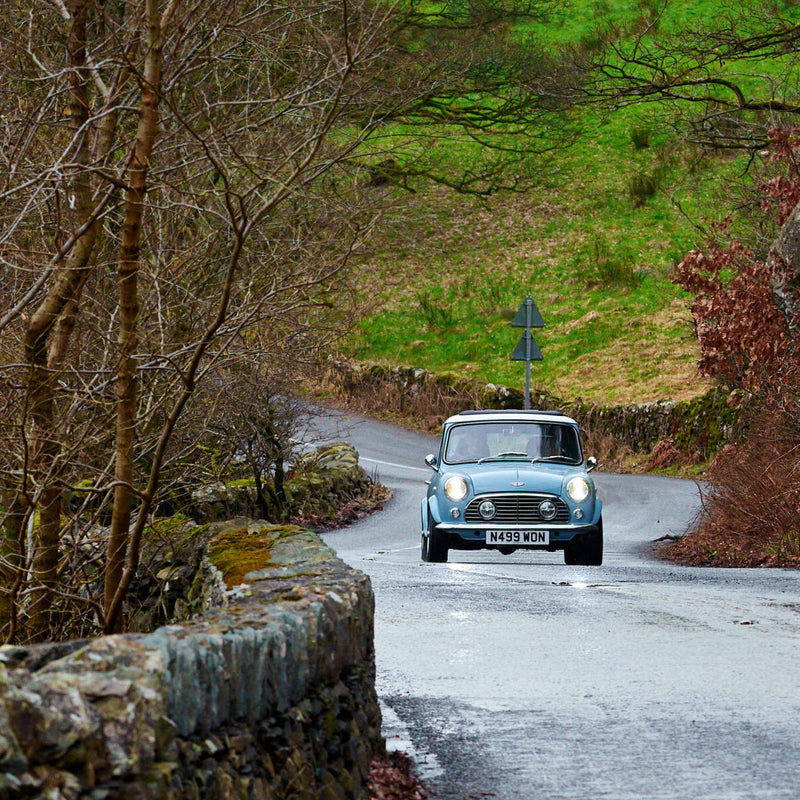I saw Sushi Factory’s first-gen Celica for the first time at the 2013 Trans Sport Show in Manila, where its classic, compact Japanese proportions mixed with the modifications to make a car that oozed cool. What some would demeaningly call its “tuner” style didn’t detract from the car’s original spirit, and all in all it looked like a very thoughtful, put-together build. A month later, I met its owner, Jeiven T. Perez, when I joined the first Sushi Midnight Run in which a group of old-school Japanese car enthusiasts met at Sushi Factory in Makati to convoy down the elevated Metro Manila “Skyway” to my neighborhood, Alabang. While several wilder builds would join us, the Sushi Celica always remained the star.
Sushi Factory introduced the Philippine car community to a new recipe for enjoying classic cars with the country’s propensity toward modifying—getting approval from all walks of life, including senior collectors, weekend racers, low-stance enthusiasts, hardcore tuners, and general gearheads. Even if they weren’t necessarily salivating over old cars, a car from Sushi Machines could likely get those glands going. While today’s vintage tuning renaissance found a new pace around the world, this company helped galvanize that mania in Manila.





We shot this selection of Sushi-modified classics on a Sunday morning in the city to avoid the notoriously thick traffic, and just like the old Midnight Runs that ended back in 2015, we took the Skyway once again, except backwards—northbound from Alabang—ending at the weekly morning meet of cars and motorcycles around Burgos Circle at Fort Bonifacio Global City. Three of the shop cars led the way: the Toyota Celica, Datsun Sunny Pickup, and Rover Mini—along with two client cars: the BMW E21 and Datsun 240Z. It’s an established name now, but where did the first of these so-called “Sushi Machines” come from?
Jeiven T. Perez is a successful architect who needed a change. He’s loved cars ever since he could remember. His grandfather is a serious collector of Porsche and Mercedes-Benz, his stepdad is a 4x4 fan who’s had Pajeros, Defenders, and Samurais, but his uncle made the biggest impact on Jeiven with his souped-up Corolla SR and EF Civic. Because his mom and stepdad were both architects too, Jeiven followed in their footsteps—working for several big architecture, construction, and interior design firms. He eventually set up his own firm, but closed it after his business partner and pregnant wife passed away.
His passion waned from the personal tragedy and the lack of creativity that accompanied. “Architecture is lucrative, but I wasn’t one of the lucky architects. It gave me money but no creative freedom,” he tells me. He was also sick of modifying civilian commuters, only to realize he was failing to make them inspiring. “They just turned into try-hard Civics,” Jeiven laughs. So, on a whim, he decided to take on some classics. After other shops let him down, he opened Sushi Factory and bought a junker Celica with no floors and a crappy chassis back in 2012, on his birthday. The hood flew off when he drove it home.

That car led to the birth of “Natsuki,” the first-gen Toyota Celica Sushi Machine. He started off with zero old-school knowhow and he neither looked at photos online nor knew what other people were doing with the chassis. Instead, he applied his knowledge of modified Honda Civics. “I knew Civics. I had that down,” he explains. “But I was totally in the dark. I didn’t really surf the Internet. I didn’t even know what a Fairlady was or Bosozoku, Shakotan, Kyushakai, etc.” He learned everything as he went along, mentored by Sison Mercado Trading (SMT), a neighboring auto performance shop.
The Sushi Celica already came with TRD-style fiberglass flares and a next-gen 1.8L 13T four-banger when he bought it, and soon enough Jeiven rebuilt and rebored the engine, got bigger dome pistons, and ported and polished the heads. He bought Weber 40 DCOE twin side draft carbs, velocity stacks, hood flutes from Spain, a new manifold and linkage from Australia, and SMT 4-to-1 high-rise headers. The weather stripping, emblems, signal lights, and mirror lenses came from Thailand, while CUSCO Japan custom-made a special strut bar for the car. Jeiven reworked the floors and chassis, then fabricated the steel ducktail, skirts, and front wing. To build the roll cage, he applied his architectural engineering knowledge. Then he added the finishing touches—the interior, 5zigen burnt-tip exhaust, the rare SSR Tomcat wheels, and the gorgeous dark lavender-gray paint.




“I was just like, ‘I want this, I want that.’ I didn’t know if it’d look good on the car, but it all came out surprisingly nice,” said Jeiven. “People sent me photos of JDM cars afterwards and I was like, ‘Oh so that’s what this is!’ I started learning about other scenes then.” Project Natsuki involved a major restomod process of trial and error that was painful and expensive at times. “This car was like a tuition fee. I learned a lot about what not to do.” This was especially true since Jeiven refused to destroy donors to complete his car. Even if he’s hyper-aware of its little flaws as only an owner can be, he’s in love with the result.




“I’m not a mechanic but it runs really well, it surprises me. We were going really fast during the shoot. I think I accidentally built the Celica so well that it’s easy to go too fast; speeding feels like you’re just cruising at 100 km/h,” he chuckles. “This car made me. It showed me what I was supposed to be. I had been earning as an architect for a decade, but I wasn’t proud of anything I made. The first time this car rolled out finished, I felt like I had my own Batmobile. I wanted something that’d reflect who I am, that feels like it’s really mine.” The Celica Sushi Machine became his calling card, and people came calling.
The 1972 Datsun 240Z that joined our shoot, shown below, was one such car. It was brought along by Jaime Flor, a 67-year-old ENT doctor with a penchant for nostalgia and adventure. “Old cars are measures of simplicity and distinctive styles that speak of the era. It’s a lifelong dream to be able to drive and own them, cars which I held in awe back when the only modes of transportation for me were jeepneys and buses,” Jaime reminisces. One of his patients tipped him off about an S30 for sale near the hospital, and Jaime nabbed it. He wanted to field it with his son, Steven, in the 1,000-kilometer Tour de Cebu historic rally. The Sushi 240Z of “Team FLOR-It” has since successfully completed Tour de Cebu three times, with Jeiven co-driving for one installment.



Steven Flor is Jaime’s 37-year-old son, documentary filmmaker, and racer of a Fairlady roadster, and after visiting Sushi Factory, Steven knew it was the right place for the Z job. The father-and-son car required total restoration and received a carbureted six-cylinder L28 engine (torquey on the low end since it was sourced from a Nissan Patrol)—now featuring a Kameari header, Fujitsubo exhaust, and triple Weber 40s tuned by carb sensei Osamu “OD” Hasegawa.


Mods for structural rigidity include a custom-made, three-point strut bar for the engine bay, and a strut tower brace for the rear shocks. Jeiven also fabricated the chin spoiler and retro bucket seats. The 240Z rally car now rocks Safari Brown paint, ZG flares, and refurbished 14-inch Nissan factory alloy wheels wrapped in Yokohama rubber. “It has performed flawlessly on all the mountains, seaside highways, dirt and asphalt roads, and bridges. Our Datsun even jumped several times, landing smoothly and confidently during Tour de Cebu.
The other client car on this shoot, the 1977 BMW E21 3-Series, was a job that Jeiven was reluctant to accept at first. Its 50-year-old owner and director of Yakult Philippines, Aldrin Vincent Dy Sun, brought the E21 to Sushi Factory with only 32,000km on the odometer. Jeiven didn’t touch it for three months, thinking Aldrin would change his mind. He finally gave in after Aldrin exhibited unrelenting commitment to releasing the E21 from its stock configuration. “I saw the Sushi Celica online and called Jeiven about widening my car. I showed him a photo of an Alpina race car, but he doesn’t copy other people's work, so we got the idea of blending German and Japanese aesthetics together,” recounted Aldrin. “I acquired it around nine years ago, and in 2015, I asked him to cut and strip my almost perfect E21. My purpose was to build a classic street racer, and I liked the concept he drew.”



Aldrin said his Bimmer was “almost” perfect because despite the mileage and condition it used to break down every three months. Ever since it got the Sushi treatment, it’s proven much more reliable. It has new triple Weber 40s, a full exhaust system by SMT with a Trust titanium muffler, upgraded Wilwood front brakes, and WORK Meister CR01 wheels. Sushi Factory custom-made its wide body flares, as well as the roll cage and simulated faded paint job as per Aldrin’s request. Aldrin also really wanted a limited-edition Sushi Factory shift knob, so he bought Jeiven’s personal piece.
“I have this old car because it reminds me of my dad, who used to have a E21 316, also in black. Jeiven transformed it into one of a kind in the Philippines. Most that I see here are usually stock with original or BBS wheels. Mine is unique because of its Japanese attitude, Japanese wheels, Japanese seats, and Japanese muffler. It looks like Darth Vader, and it sounds beautiful at high revs,” said Aldrin. “My car usually attracts attention from older guys and Europeans. I’m very satisfied regardless of who else is though. When my engine finally blows, I plan to upgrade the displacement and pistons, then get racing carbs and some coilovers.”



Sushi Factory’s 1990s-era Rover Mini, “Makino,” with its 998cc engine, is another shop car (driven by our buddy Phil de Lange on the day-of). Jeiven’s stepdad actually gave him the Mini to distract him from the dark period in his life, but the Celica ended up taking precedence. At first Jeiven wanted to build a Works Mini, but decided on a Japanese look when he became more familiar with the JDM scene. “The British go for the rally works image, the Aussies like modifying them for more power, the Japanese go for a meaner look—clean, crisp, but with dulled colors.” Jeiven rebuilt the engine and gave it a port-and-polish job, Weber carbs, and new exhaust. He reinforced the chassis and built its roll cage, while his current wife Graz Gonzales gifted him its Rose Petal wheels.





Speaking of Graz, Jeiven built the Datsun B120 Sunny Pickup pictured here for her—based on one of the service vehicles that the Philippines was still making into the 1990s. That localization has made the B120 one of the easiest cars to build here, with parts readily available in many an auto supply shop. Graz always wanted one, so Jeiven acquired hers from a fellow Sunny enthusiast (Jose Arcenas of My Sunny Adventures) for their wedding in 2018.
“She only likes driving manuals, and I wanted to make her something nice and reliable with cold air-conditioning—a car that’d work well in traffic and help transport her plants for her gardening hobby,” Jeiven tells me. What started out as a provincial junker now has a 1.2L A12 four-banger with carbs from the US, a new old stock steering box, a wagon grille from Malaysia, and Watanabe wheels. The front end was cut to fit a Civic condenser and bigger radiator, and Jeiven lowered the original leaf springs. Graz was busy during our drive, so Steven Flor drove the Datsun Sunny Pickup for the shoot (in fact, he and Jeiven drove for each other’s weddings as well).





“Sushi Machines have a certain style. Look at my cars. If you like what you see, that’s what you’re going to get. Otherwise, I can’t promise to do what you want well,” insists Jeiven. Someone tried to task him with a vintage Alfa Romeo race car, but Jeiven recommended more prestigious restoration shops instead. “Don’t ask me to make you a ‘Concours’ car. I might risk that attempt with my own car, but I wouldn’t risk it with yours… With how the world is today, you have to be kind, honest, and in the right as much as you can. Be transparent. If you know you might do a bad job, don’t do it.”

Sushi Factory gets its share of international inquiries, but there are things Jeiven either can’t or won’t do, rather than half-ass anything. He won’t mass-produce parts for instance, because he might get bored with that kind of business, and doesn’t want to leave anyone in the lurch. He’s still a freelance architect, who’d rather paint and draw in his spare time. He also won’t reproduce his work: “My clients come to me for their own unique thing. I don’t want to violate that.” There are also some limitations; for example, a Hakosuka group in Japan wanted Sushi roll cages, but Jeiven didn’t have a car in Manila to work with. “There’s a certain pride when Japanese guys ask for your help to build their cars. Unfortunately, people in the Philippines only really appreciate you once you get recognition abroad. I made some Sushi shift knobs and the Japanese liked them, you can see one in Shoji’s Star Road Z.
“Sushi is Sushi because the cars are raw. I didn’t want cars that feel overly ‘finished.’ I build cars wherein you can hear everything. I don’t consider any project perfect, so I want to be able to hear if anything is wrong, and fix it. Maybe I’m getting better because, lately, clients don’t come back as often for tweaks. They say these old cars need maintenance, but I find myself not spending for repairs, but for improvements. If you do it right the first time, a car will be ready for you whenever you want. That’s what I’m so proud of. I’ll get into the Celica and it will start any given day,” Jeiven beams.


“You know what the ‘PHDM’ thing is? We’re in love with Toyotas and Mitsubishis, they’re part of our childhoods. They were the race cars of the cool kids back in the day. Filipinos are some of the best Toyota builders in the world, although I wouldn’t include myself with them. Filipinos want perfect, shiny Toyotas with the best performance parts and zero rust…
“Friends will ask me, ‘Would this and that suit my car? Is it okay?’ They’re starting to realize that choosing something from the heart isn’t so bad. If someone says otherwise, do you really have to listen? Just build a car to please yourself, not others.”
For someone with a somewhat boy-racer-type background, Jeiven may have built “Natsuki” to please himself, but has earned Sushi Factory fans all over the world in the process. While there are different genres, tribes, and philosophies of old-school enthusiasm, the pursuit of beauty, performance, and self-expression is universal.


























































